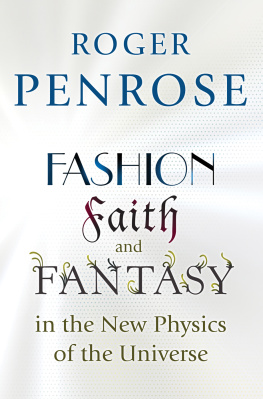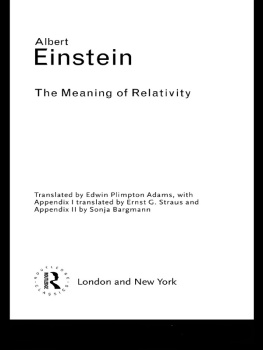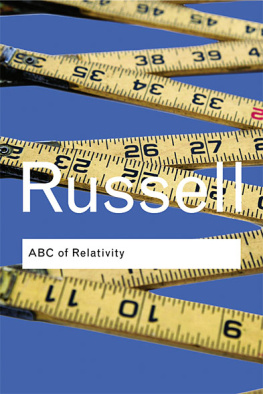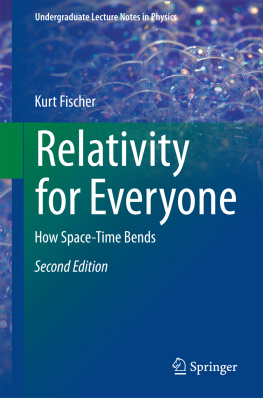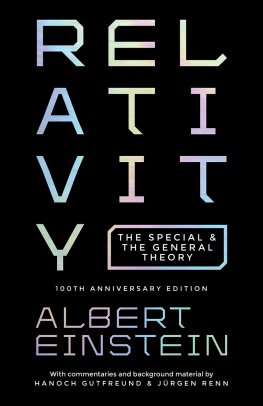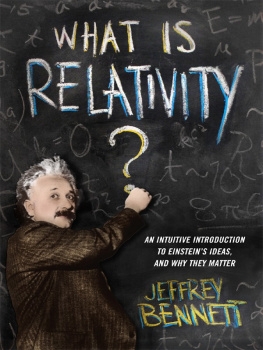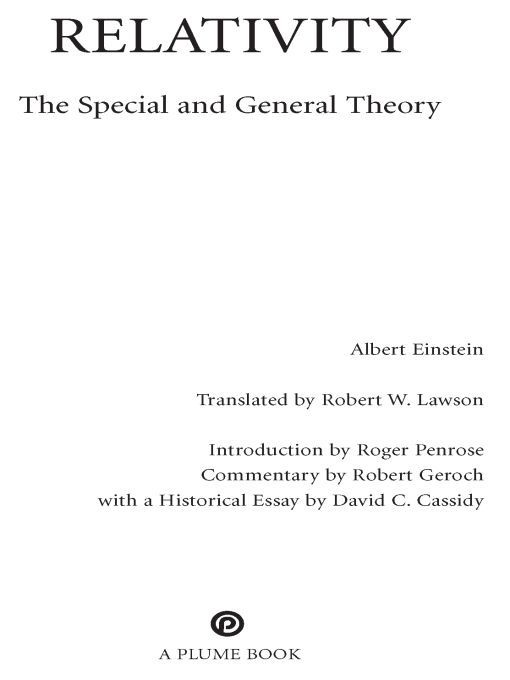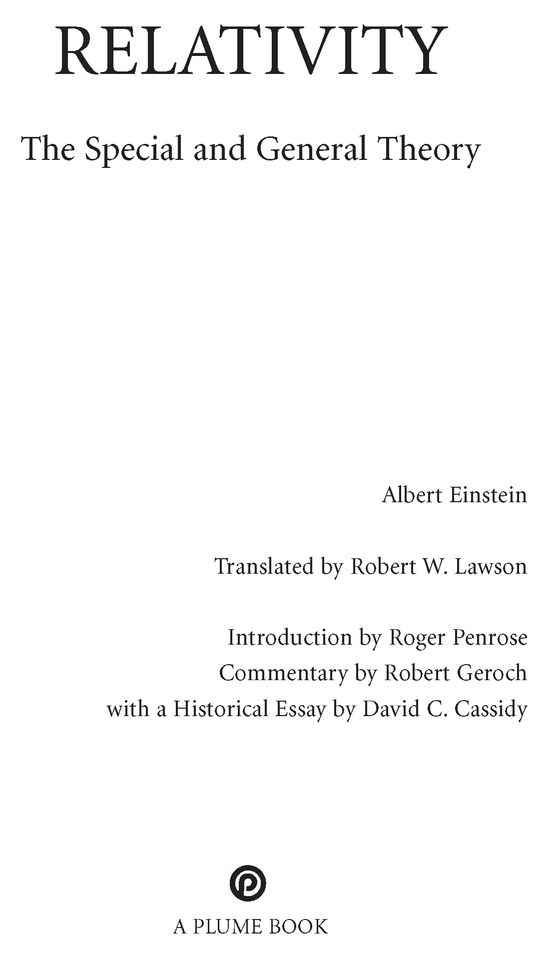Table of Contents
A PLUME BOOK
RELATIVITY
ROGER PENROSE is Emeritus Rouse Ball Professor of Mathematics at Oxford University. He is the author of a number of books, including The Road to Reality: A Complete Guide to the Laws of the Universe and The Emperors New Mind: Concerning Computers, Minds, and the Laws of Physics.
ROBERT GEROCH is a professor of physics at the University of Chicago. He received his Ph.D. at Princeton University, and has held positions at the University of London, Syracuse University, and the University of Texas. He is the author of General Relativity from A to B.
DAVID C. CASSIDY is a professor of natural sciences at Hofstra University. He served as associate editor of The Collected Papers of Albert Einstein, and is the author of Einstein and Our World, Uncertainty: The Life and Science of Werner Heisenberg, and J. Robert Oppenheimer and the American Century.
INTRODUCTION
Roger Penrose
Albert Einstein put forward his special theory of relativity in 1905, and he fully formulated his general theory ten years later, in 1915, publishing it in 1916. His account of these theories in this book Relativity: The Special and General Theory first appeared (in the original German edition) also in 1916. It is remarkableand, in my view, very gratifyingthat he should have produced such an account for the lay public so soon after his general theory was completed. That theory, in particular, presented an extraordinary and revolutionary view of the physical world, providing profound new insights for our conceptions of space, time, and gravitation. This view has now superbly survived the tests of time. When Einstein first put forward his general theory almost ninety years ago, there was inevitably a deep and widespread curiosity, among the general public, as to the actual nature of his revolutionary ideas, and there was an equally inevitable scope for misunderstandings of various kinds. There was, accordingly, an immediate need for an accessible account from the master himself. Relativity helped enormously in minimizing such misunderstandings. But, even today, there are many physicists who have not fully come to terms with the revolutions in physical world-view that Einstein presented. The reprinting of Einsteins account to coincide with the centenary of the special theory is therefore indeed timely. In this edition we are also fortunate in having the advantage of an excellent exposition of Einsteins foundational ideas on relativity from a more modern perspective in Robert Gerochs commentary.
It should be pointed out that of these two relativity revolutions, it was the general theory that was Einsteins most uniquely original contribution. Special relativitythe relativity theory that Einstein put forward, among other fundamental advances, in what has become known as his Miraculous Year of 1905was far less uniquely Einsteins own achievement. That theory was concerned with the puzzling transformations that mix up space and time, as is needed when the relative velocity between the reference frames of different observers approaches that of light. But these transformations had been in the air for some time prior to Einstein entering the scene. Others before him, particularly the outstanding Dutch physicist Hendrik Antoon Lorentz and the great French mathematician Henri Poincar, had already formulated the essential ideas and transformations several years before Einsteinalthough they had not appreciated the full nature of the revolution, nor the virtue of taking the relativity principle as axiomatic for physical forces generally. (Apparently the British physicist Joseph Larmor also had these transformations before both of them, and there were partial results of this nature earlier still, by the German physicist Woldemar Voigt and the Irishman George Francis FitzGerald.) Moreover, it is my view that even Einstein had not fully understood the nature of special relativity in 1905, as it was not until 1908 that the final mathematical insights were provided by the highly original Russian-German geometer Hermann Minkowski (who had, coincidentally, been one of Einsteins teachers at the Federal Institute of Technology in Zurich in the late 1890s). It was Minkowskis idea to combine time with space, and to describe physical processes as inhabitants of the four-dimensional space, now referred to as space-time.
It took Einstein some while to appreciate the virtue of Minkowskis four-dimensional perspective. Even in the account that he gives here, he betrays some unease with Minkowskis viewpoint, emphasizing the analogy with Euclidean geometry, but with an imaginary time-coordinate (i.e., measured in units involving -1 , which I regard as somewhat misleading) and he does not describe this space-time geometry in the way that I believe to be most physically direct. Physically realizable curves in space-time are timelike, and hence, as is reflected in more modern accounts, the metric is really supplying a measure of time to the curve, rather than length. In the excellent expositions by such relativity experts as John Leighton Synge and Hermann Bondi, it has been emphasized that space-time geometry is really chronometry rather than geometry in the ordinary sense, so that it is clocks that express the metric better than the little rulers that Einstein used in his descriptions. Rulers do not directly measure (space-like) space-time intervals: because they require, in addition, some means of determination of simultaneity, they are rather confusing in this regard. Clocks, however, do directly provide a measure of (timelike) space-time intervals, and they directly provide a good and superbly accurate measure the space-time geometry. (Indeed, the modern definition of a meter is now given in terms of a time measure, as precisely 1/299,792,458 of a light-second.) I would say that, in many respects, this book will be enjoyed as much for its historical insights into the time when the theory of relativity was young, as for its exposition of the very nature of Einsteins wonderful theories of relativity.
Einstein depended upon Minkowskis space-time idea for the generalizations that he needed in order to incorporate gravity into Minkowskis picture, whereby the general theory of relativity could be formulated. This theory was of a kindalmost unique in scientific developmentwhere it is not unreasonable to suppose that, had Einstein not been there, the theory might well still not have been found by anyone, a century or more later. As I mentioned earlier, the work of many individuals contributed to special relativity, and the theory would still have come early in the twentieth century without Einstein. But the general theory required a different order of originality, and it is hard to see any plausible train of thought that would have clearly guided others to this theory.
Minkowskis geometry for special relativity was a flat onebasically a version of Euclids ancient geometry of three-dimensional space, but one where Minkowski needed to modify Euclids geometry, not just from three to four dimensions, but also in a way that is appropriate for a theory of space-time rather than just of space (using what we now call a Lorentzian metric). Minkowski space provides the background for special relativity, but it does not incorporate gravity. What Einstein found that he needed was an


